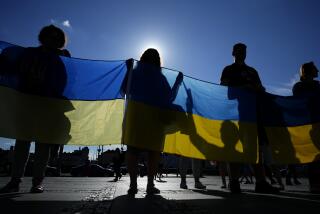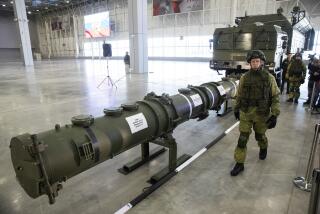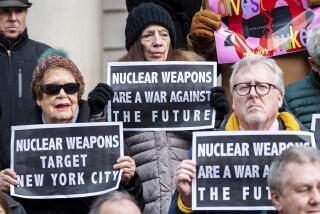‘A Changing Relationship’ : U.S., Soviets Build Trust as Missiles Are Destroyed
- Share via
MOSCOW — When Brig. Gen. Roland Lajoie was a military attache in Moscow, he spent days thinking about how he might get a close look at one of the Soviet Union’s new SS-20 intermediate-range missiles, a fearsome weapon that threatened to change the strategic balance in Europe.
He took his camera with its telescopic lens to the military parades in Red Square, he stayed out late at night to watch parade rehearsals, he traveled a lot by train to areas where satellite photographs showed suspected deployments and he did a lot of other things that skirt the narrow line separating the tolerated observations of a military attache from espionage.
But the SS-20s were largely out of his reach--in areas closed to foreigners, covered or in special freight cars when they moved by train and always well guarded.
So, when Lajoie found himself taking shelter from the rain with a Soviet colonel inside the cigar-shaped canister of an SS-20 recently at the Soviet Union’s top-secret Kapustin Yar missile range, southeast of Volgograd, he allowed himself a few moments of reflection.
“There is a little bit of professional excitement when you get access to something like this, something that you have been coveting for a long time,” he said later in an interview here. “Until then, I had only seen this weapon system from afar. There I was, and it was pretty amazing.”
The missile in whose canister Lajoie stood was about to be destroyed--one of three that were blown up at Kapustin Yar with their own propellant and detonated with a charge of dynamite--under the Soviet-American treaty calling for elimination of all land-based nuclear missiles with ranges between 300 and 3,400 miles. Over the next three years, 1,752 Soviet and 859 U.S. short- and intermediate-range missiles will be destroyed.
Lajoie, director of the recently established U.S. On-Site Inspection Agency, which was formed by the Pentagon to monitor compliance with the Intermediate-range Nuclear Forces (INF) Treaty, was at Kapustin Yar heading a team of American specialists observing the destruction of the missiles, the first group of the two-stage SS-20s to be eliminated.
“It is all pretty amazing, in fact--this treaty, the things that we are doing under it and how well its implementation has gone so far,” Lajoie commented. “It is a changing relationship.”
There were ironies for the Soviet officers at Kapustin Yar, too.
Lt. Col. Sergei Galchenko, who commands the elimination base there, recalled how he had taken part in the first tests of the SS-20s in the early 1970s as a young lieutenant and how he came to see those missiles as an important weapon in the Soviet arsenal, part of the Soviet nuclear deterrent against war.
‘It Is Not Easy’
“Of course, it is not easy to destroy with my own hands these sophisticated missiles,” Galchenko said. “However, the elimination of medium-range missiles is the first step toward real disarmament.”
While the Soviet and U.S. officers implementing the treaty still warily regard one another as potential adversaries, they are finding they can cooperate quite closely in a mission that few ever thought would come about--the inspection of some of the other country’s most sensitive military facilities and the destruction of a whole category of weapons.
And this shift to cooperation, limited but highly symbolic, promises to have a broader, more profound impact than either side expected.
“A year ago, while negotiations for the treaty were still under way, I personally would not have expected the results that we have achieved so far,” Lt. Gen. Nikolai V. Mazyarkin, commander of the Kapustin Yar range, said in a brief conversation with foreign reporters at the base.
‘We Are Building Trust’
“Yet, I can see that not only are we reducing the nuclear threat the world faces, and that is very good, but through cooperating with each other and opening up, one to the other, I can see that we are building trust between our two countries. . . .
“This development of trust between the officers of our two armies is an unexpected but very welcome result of the treaty. . . . We are getting to know one another in a way I never anticipated--how could I ever think that I would be showing Gen. Lajoie around Kapustin Yar? And it is a far better way to get acquainted than the one for which we trained and prepared.”
As they carry out their inspection visits here, in Europe and in the United States under the treaty, their professional respect for each other is growing, officers from both countries say.
“The Soviets have proved to be very well organized,” another senior U.S. officer commented. “In carrying out 115 inspections here in the (initial) period, we have taxed their resources, we have taxed their logistics capability, we have taxed their military management system and we have undoubtedly taxed their patience as well. Their response, across the board, has been outstanding.”
‘Appreciate U.S. Approach’
A Soviet officer who has been on several of the 31 inspections made at U.S. and North Atlantic Treaty Organization bases added: “We have learned to appreciate in a new way the ‘can-do’ approach of the American military . . . and I must say that we work not to be outdone. This sort of competition is healthier, not to say safer.”
The officers, trained to regard each other as potential enemies, continue to marvel over the experience of working closely to ensure not only full compliance with the complex agreement but the satisfaction of the other side.
“Psychologically, it is a difficult job to explode missiles that took such a big effort to make,” remarked Col. Yevgeny Solovyov, who entered the Soviet army’s strategic rocket force as a 20-year-old lieutenant at Kapustin Yar. “But we regard the missile explosion work as important since it will help reduce the risk of a nuclear war. We also realize that this missile was built primarily for deterrence of war, and it accomplished that task. Now you can say that, as it is eliminated, it is helping us strengthen peace.”
Looking Toward 50% Reduction
The experience has also encouraged officers from both countries to look beyond the elimination of these missiles, mostly Soviet SS-12s and SS-20s and the U.S. Pershing 1-A and Pershing 2 and new ground-launched cruise missiles, and to consider how the 50% reduction of strategic missiles now under negotiation might be carried out.
“Much of the strength of the INF agreement, we realize, lies in the way that it is implemented,” Col. Gen. Nikolai F. Chervov, a senior Soviet staff officer, commented during a recent Soviet-American discussion of arms control issues. He argued that the process could become as important for broader questions of arms control as the actual result.
“We want to eliminate not only this class of weapons but to proceed to other classes,” Chervov said. “It is important to implement this agreement well to lay the basis for future agreements.”
And, with the experience from this treaty as well as further development of satellite surveillance, officers from both countries believe that procedures could be developed to verify compliance with a strategic arms reduction treaty, known as START.
‘Seems Less Awesome’
After three months of inspections and observation of missile destruction, which are now under way in both the Soviet Union and the United States, Lajoie said, “START seems less awesome, though it is a problem of another dimension with thousands of systems, some air- and sea-based, not just on land, and (weapons) being reduced, not eliminated.”
U.S. officers are confident of their ability to monitor Soviet compliance with the current treaty, noting that the data provided by Moscow in May when the treaty was ratified was fuller than the information that Washington had already gathered through its intelligence efforts.
“When we inspect a base, we leave confident that the (missile) count is correct,” Lajoie said. “We have looked in every building, every shed large enough to hold one of these weapons or their major components.”
Satellite surveillance complements the on-site inspection, he said, and makes it impossible to retain an SS-20 force secretly. The satellites would quickly spot new activity appearing to be a supporting infrastructure for the missiles, unit training and operational tests, U.S. officers say.
Cheating Seen as Unlikely
“There is no way to maintain a covert force,” one senior American officer said, “and having gone this far, it is impossible to see why they would want to destroy the agreement and this new relationship by cheating.”
Discussing the possible strategic arms reduction agreement, he added: “Much would depend on how the verification regime is designed, how precisely it is drafted, how much of our experience here is directly transferable. . . . But I am confident we could do it if an arms reduction treaty is reached.”
Treaty verification, he noted, combines an exchange of data, monitoring by surveillance satellites and other “national technical means” and the critical on-site inspections, which Washington had long sought in arms negotiations but which were fully accepted by Moscow only in the INF treaty.
Most of the facilities the American and Soviet officers inspect remain top-secret installations, but they have been carefully “sanitized,” Lajoie said.
No ‘Freebies’
“You don’t jump into the normal rhythm of a garrison on one of these inspections,” he continued. “The installation has been pretty much vacuumed. There is no normal traffic, troops, training or maintenance going on. Miscellaneous instructions, maybe for maintenance, on the wall are covered, and so are serial numbers. We do the same thing, of course. Each makes sure that the other guy doesn’t get any freebies.”
Yet, the sense of wonder is strong among both groups of officers, whose contacts already number in the hundreds and will multiply many times over the course of the 13 years of inspections for which the treaty provides.
“If I had shown you all this a year ago,” one Soviet officer told his American counterpart during an inspection of an SS-20 base, “I would have been arrested, court-martialed and quite probably shot for treason. That’s change, real change.”
More to Read
Sign up for Essential California
The most important California stories and recommendations in your inbox every morning.
You may occasionally receive promotional content from the Los Angeles Times.













